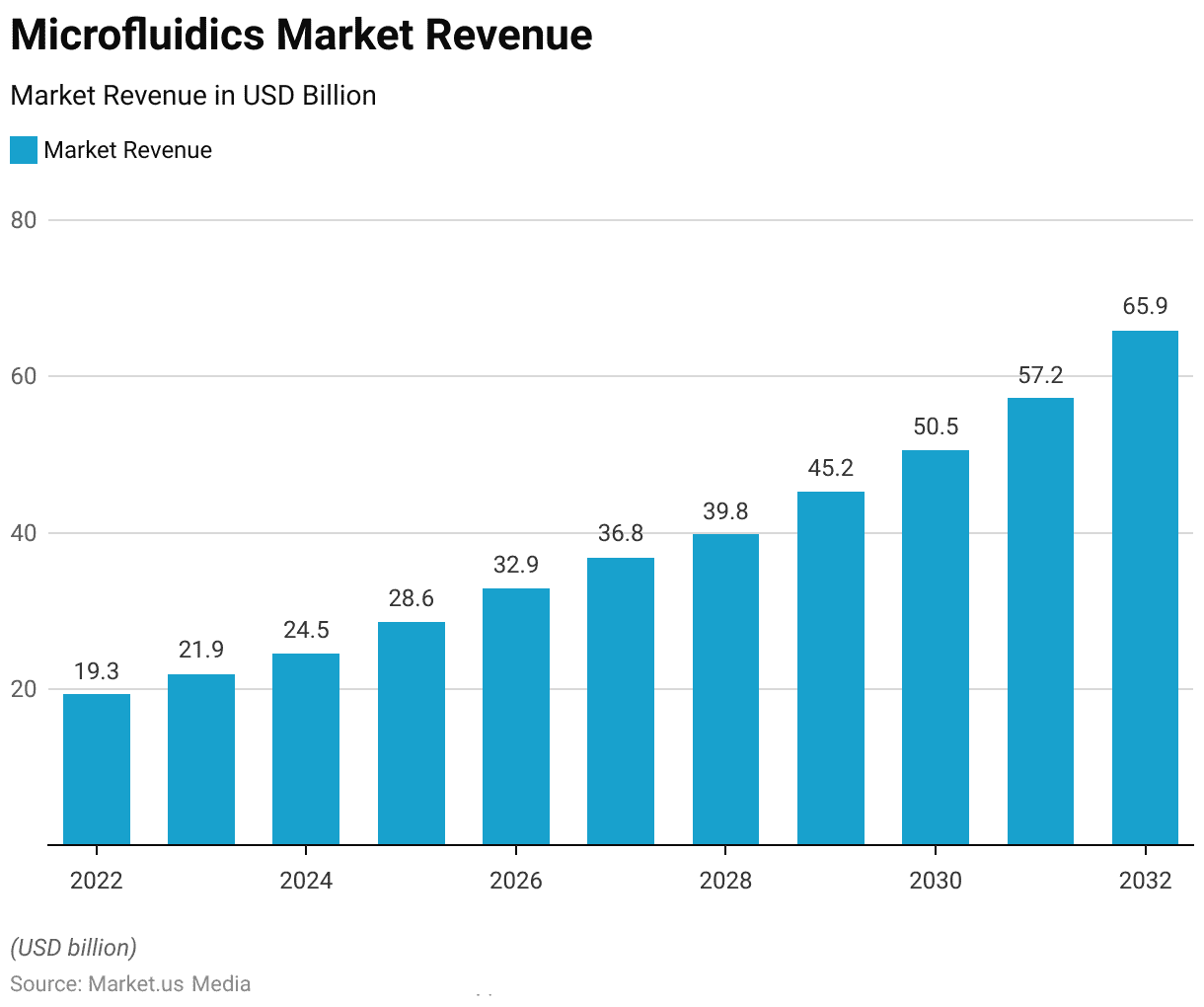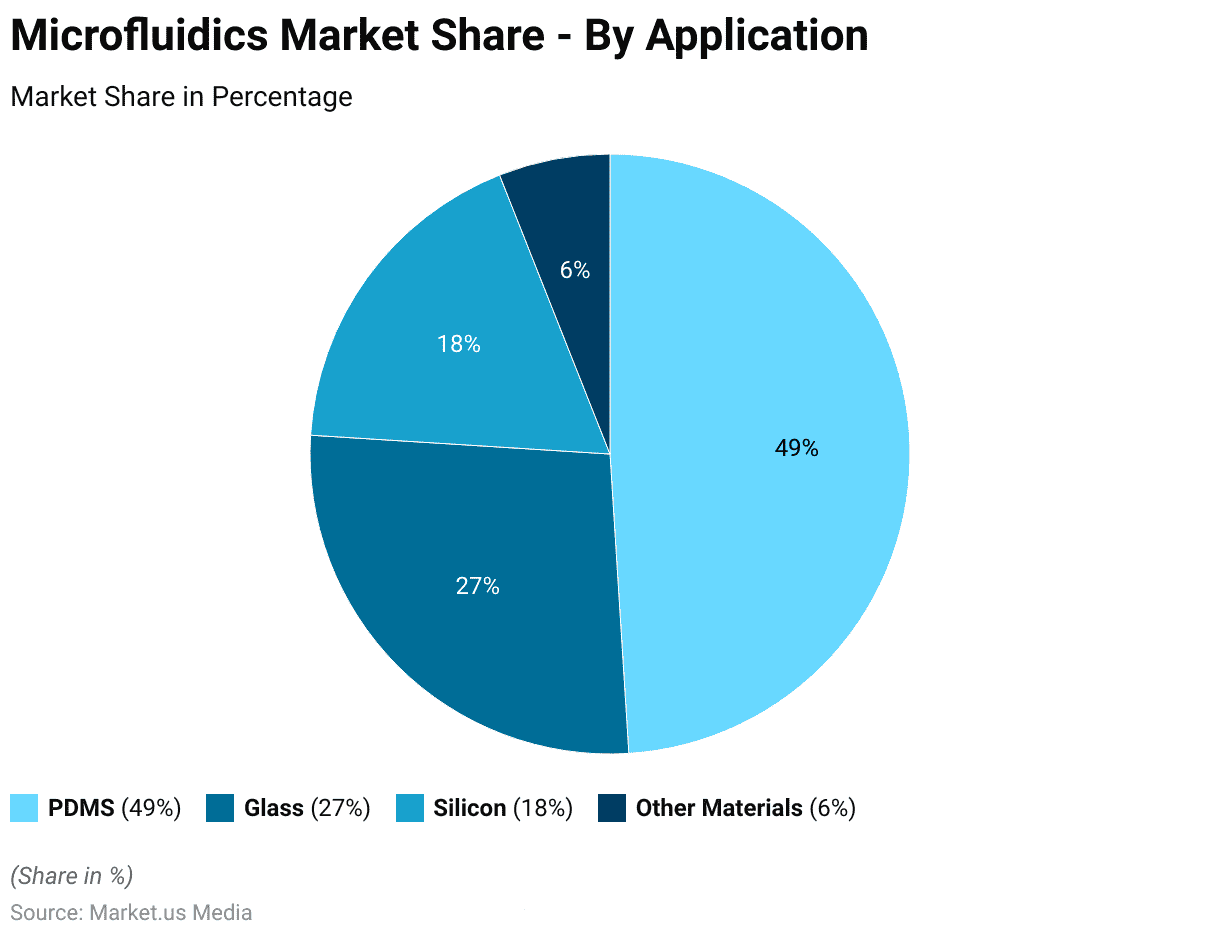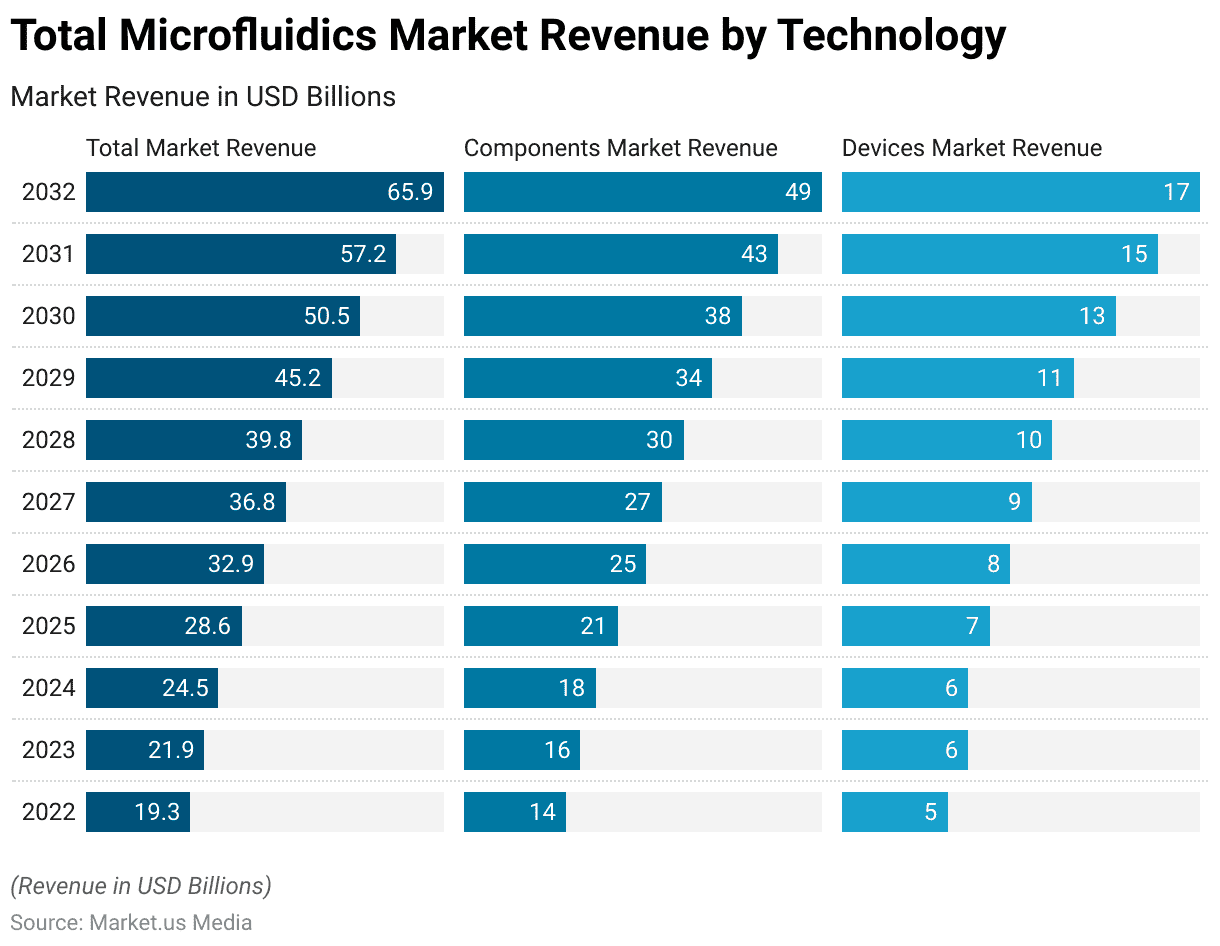Table of Contents
- Introduction
- Editor’s Choice
- Global Microfluidics Market Overview
- Microfluidics Market Share- By Application
- Regional Analysis of Microfluidics Market
- Materials Used for The Fabrication of Microfluidic Platforms
- Droplet Microfluidics
- Applications of Microfluidics Technology
- Microfluidics in Oil and Gas Industry
Introduction
According to Microfluidics Statistics, Microfluidics is the manipulation of small fluid volumes at the microscale, offering advantages such as reduced reagent usage and enhanced control, with applications spanning biomedicine, drug delivery, chemistry, and materials science.
Microfluidic systems consist of microchannels, valves, pumps, and sensors fabricated using techniques like soft lithography. Challenges include scaling for industrial use, standardization, and system robustness.
Despite challenges, microfluidics has profoundly impacted research and industries, revolutionizing fields like healthcare and materials science by exploiting unique microscale fluid behaviors.
Editor’s Choice
- The microfluidics market has exhibited robust growth in recent years, with a clear upward trajectory in revenue at a compound annual growth rate (CAGR) of 15.5%.
- In 2022, the market generated approximately USD 19.3 billion in revenue.
- The microfluidics market is expected to grow significantly, with revenue forecasted to reach USD 65.9 billion in 2032.
- By 2032, the market is expected to reach USD 65.9 billion, comprising USD 49 billion in components and USD 17 billion in devices.
- Polydimethylsiloxane (PDMS) dominates with the lion’s share in microfluidics applications, commanding a substantial 49% of the market.
- In 2021, North America claimed the largest portion of revenue at 42.5%.
- Microfluidic devices encompass microchannels that span from dimensions as small as a sub-micron (measured in millionths of a meter) to a few millimeters.
Global Microfluidics Market Overview
Microfluidics Market Size
- The microfluidics market has exhibited robust growth in recent years, with a clear upward trajectory in revenue at a compound annual growth rate (CAGR) of 15.5%.
- In 2022, the market generated approximately USD 19.3 billion in revenue.
- Over the subsequent years, this revenue is projected to steadily increase, reaching USD 21.9 billion in 2023, USD 24.5 billion in 2024, and USD 28.6 billion in 2025.
- The microfluidics market is expected to grow significantly, with revenues forecasted to reach USD 57.2 billion in 2031 and USD 65.9 billion in 2032.

Global Microfluidics Market Revenue- By Product
- The global microfluidics market has demonstrated a robust and steadily ascending growth pattern.
- In 2022, the total market revenue amounted to USD 19.3 billion, with components contributing USD 14 billion and devices adding USD 5 billion to the overall figure.
- By 2032, the market is expected to reach USD 65.9 billion, comprising USD 49 billion in components and USD 17 billion in devices.
- In the realm of microfluidics applications, different materials play a pivotal role in shaping the landscape.
- Polydimethylsiloxane (PDMS) dominates with the lion’s share, commanding a substantial 49% of the market.
- Glass follows closely behind, holding a significant 27% market share.
- Silicon, renowned for its precision and durability, accounts for 18% of the market.
- Meanwhile, other materials collectively constitute 6% of the microfluidics application market.

Regional Analysis of Microfluidics Market
- In 2021, North America claimed the largest portion of revenue at 42.5%.
- The presence of both emerging and established microfluidics manufacturers, particularly in the United States, played a pivotal role in this region’s dominance from 2023-2032.
- The Asia Pacific region is poised for substantial growth, with an anticipated growth rate of 17.1% in the forecast period.
Materials Used for The Fabrication of Microfluidic Platforms
- When considering materials for fabricating microfluidic platforms, weighing various features to meet specific application requirements is essential.
- Metals offer low-cost advantages but have limited flexibility due to their high Young’s modulus (100–200 GPa) and low oxygen permeability.
- Silicon and glass provide excellent mechanical properties and optical clarity but are expensive and challenging to fabricate with submicron channels.
- Ceramics offer good mechanical strength but can be brittle and require specialized techniques.
- Elastomers stand out with their flexibility, low Young’s modulus (~0.0005 GPa), and ease of fabrication, but may not be suitable for all applications.
- Thermoplastics provide ease of fabrication and low absorption but lack flexibility. Resins are versatile and can be chemically modified, while hydrogels are biocompatible but can be less mechanically robust.
- Paper is low-cost and suitable for certain applications, and hybrid/composite materials offer a combination of properties.
Droplet Microfluidics
- Droplet microfluidic technology employs tiny liquid droplets separated by an immiscible fluid to create independent reaction vessels, typically in nanoliter to picoliter volumes, allowing for experiments in a continuous or segmented flow manner.
- Unlike the traditional method of screening drug compound libraries using 96-well plates for potential bioactivity, droplet microfluidic platforms offer significant advantages.
- They demand far less sample usage, approximately 200 times less than a 96-well plate, and considerably shorter reaction times, mainly due to a higher surface-to-volume ratio (2.5 minutes versus 2 hours).

Applications of Microfluidics Technology
Drug screening
- Drug development is a complex and lengthy endeavor involving substantial financial investments.
- Taking a new compound from its inception to market availability is a protracted process, typically spanning a decade or more and incurring costs ranging from $1.5 billion to over $1.8 billion.
- There is an urgent need for more efficient and cost-efficient methods to assess and confirm potential drug candidates to streamline and cost-effectively manage the drug discovery process.
- Compared to traditional cell assay systems, the emerging technology of microfluidic chips is notably advantageous in high-throughput drug screening (HTDS).
3D Cell Culture
- 3D cell culture represents an innovative approach to cell cultivation, and when combined with the distinctive structural features of microfluidic chips, it significantly enhances its advantages and applications.
- Microfluidic devices offer a highly efficient means for drug screening, facilitating high-throughput screening processes.
- In recent times, diverse microfluidic devices capable of fostering the creation of 3D cell spheroids have found application in vitro testing of anti-cancer drugs with a focus on tumor spheroids.
- These devices aim to replicate tumor tissues’ complex and heterogeneous nature to assess the cytotoxic effects of anticancer drugs.
Drug Detection
- Microfluidic detection technology is gaining prominence as a highly promising analytical tool due to its advantages, including its compact size, minimal energy consumption, reduced use of reagents, and minimized waste generation.
- An innovative hybrid microfluidic device with UV detection has been crafted for the identification and quantification of three distinct psychotropic drugs.
- This inventive approach amalgamates extraction and concentration processes within a single microchip, reducing analysis duration and heightened detection sensitivity.
- Remarkably, it accomplishes the separation of these drugs at their baseline within a mere 200 seconds, achieving an impressive separation efficiency of up to 3.80×105 plates/m. This constitutes a significant advancement.
Medical Diagnostics
- Microfluidic devices encompass microchannels spanning dimensions as small as sub-micron (measured in millionths of a meter) to a few millimeters (measured in thousandths of a meter).
- To put this in perspective, human hair typically has a thickness of about 100 microns (millionths of a meter).
- Microfluidics has gained increasing traction in biological sciences due to its ability to facilitate precise and controlled experiments at a reduced cost and accelerated pace.
- An example of this progress is demonstrated by Hesperos, a company based in Orlando, United States, which has successfully developed a microfluidic laboratory capable of overseeing up to five different organs simultaneously, enabling the observation of dynamic interactions among these organs.
- The channels within microfluidic devices can assume various shapes, including square or round, with dimensions ranging from a few micrometers (millionths of a meter) to 800-900 μm (billionths of a meter).
Microfluidics in Oil and Gas Industry
- In the early stages of microfluidics, limitations were evident regarding pressure and temperature capabilities.
- It’s only in recent times that many companies managed to achieve conditions relevant to reservoir studies, reaching pressures as high as 1000 bar and temperatures up to 200 ℃.
- Building upon this progress, similar interconnection systems have been developed, valued for their simplicity and durability.
- These studies encompassed measurements such as determining gas-oil ratios at 376 bar and 15 ℃ constructing full pressure-temperature phase diagrams at 67 bar and 90 ℃.
- Building on this foundation, Interface Fluidics has further advanced this research by delving into areas like measuring CO2 solubility in oil, diffusivity, extraction pressure, miscibility, and contact angle at conditions of 130 bar and 50 ℃.
Discuss your needs with our analyst
Please share your requirements with more details so our analyst can check if they can solve your problem(s)



